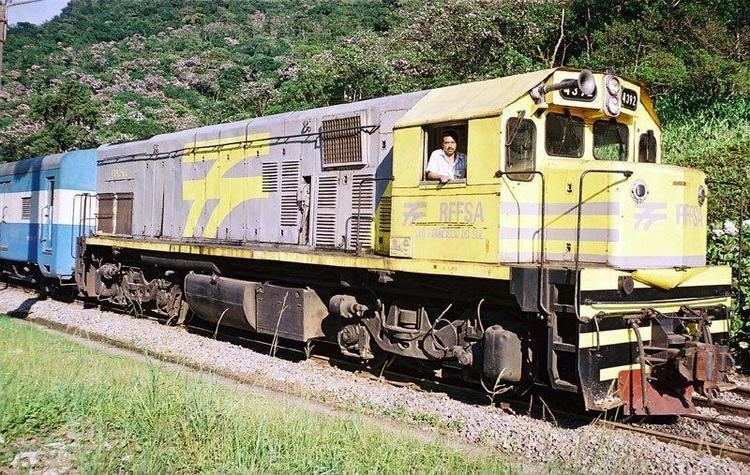Power type Diesel-electric Total produced 635 | Model G22 AAR wheel arr. B-B, C-c | |
 | ||
Builder Various licencees from Electro-Motive Division (see models listed) Build date January 1969 - November 1991 | ||
The EMD G22 Locomotive Series made their debut in 1967 after the rise in popularity of the export EMD G12. Designed to meet most First World, Second World and Third World countries, the G22 Series were now equipped with a naturally aspirated EMD 645 Series engine as well as four axle Flexicoil Type-B trucks which carry a low per-axle weight. Based on customer input, the G22 Series would be defined by various designations that suit the customer's railway operations.
Contents
The standard suffixes applied after the G22 designation were if the customer purchased locomotives with specific traction motors to fit Narrow Gauge (U) or Broad Gauge (W) rails. As the years progressed, the customers began to have more options available for their locomotives such as EMD Dash 2 Electronics, Alternators instead of Generators, A-1-A running gear and/or steam generators, etc.
The G22 designation can freely apply to the designs of any EMD export model or a licensee of EMD as long as the electrical and mechanical gear were left unaltered.
Overview
With the introduction of the 645 engine in export models in 1967, the model numbers changed by adding "10". Thus the G12 now became the G22. This new model was an upgrade from the 567 series G12 and brought forward various innovations for almost four decades. To this day, the G22 series is the most common diesel found in Brazil, New Zealand and in Egypt.
The G22 Series was one of the first models to be commonly constructed outside of the United States and to have its own separate designation based on traction motors/gauge, generator, etc. Unlike the G12, which its six axle version was the GR12, the six axle version of the G22 Series was designated as G22C. The customer then had options to apply on the locomotive as desired.
Several models were introduced:
G22W
The G22W first appeared in 1967. To separate itself from its predecessor, the G22W was identified by a W suffix to indicate that this model was supplied with traction motors adjustable only for Wide gauged rails (Standard gauge up to Indian gauge).
The G22W model found success among several buyers and were also built in different countries to suit the customers needs. One notable difference in the carbody design came with the order of Swedish G22Ws. Completely redesigned to meet the Scandinavian weather conditions, these units resemble a G22W only by their internal electrical and mechanical equipment.
Production spanned from 1967 to 1989.
G22U
The G22U appeared alongside its wide gauge counterpart in 1969. To separate itself from its predecessor G12 as well as the G22W, the G22U was identified by a U suffix to indicate that this model was supplied with traction motors adjustable to any rail gauge Universally (Metre Gauge up to Irish Gauge).
The G22U model found success among several buyers and were also built in different countries to suit the customers needs. The Yugoslav locomotives were equipped with a steam generator located in the high short hood. Both the Yugoslav Railways and Taiwan Railroad Administration purchased their G22U’s with a unique A-1-A running gear configuration. This did not alter the models designation as the center axles were not powered nor were A-1-A trucks widely produced at the time.
This locomotive found itself to be very successful in the metre gauge lines of Brazil, as where most lines did not permit the use of six-axle locomotives around tight curves.
Production spanned from 1969 to 1974.
G22W-AC
The G22W-AC first appeared in 1980. To separate itself from the base model G22, the G22W-AC was identified by an AC suffix to indicate that this model is supplied with an alternator that provides Alternating Current to the traction motors suited for Wide gauged rails (Standard Gauge up to Irish Gauge). This now increased reliability and reduced electrical problems derived from Direct Current.
Production spanned from 1980 to 1991.
G22W-2
The G22W-2 first appeared in 1991. To separate itself from the base model G22, the G22W-2 is identified by a -2 suffix to indicate that this model is supplied with DC Current -2 electronics only for traction motors adjustable for Wide gauged rails (Standard Gauge up to Irish Gauge). This now improved availability, efficiency and ease of maintenance of the locomotive.
Phasing
Only two general variations have been noticed during the G22 production, most notably on the constant production of the RFFSA G22Us.
There have been various as-modifications on railroads as well, but are excluded due to various degrees of completion on the modification.
Models
The G22U/G22W model is represented in HO Scale by Frateschi trains of Brazil. Due to the accommodation of the motor, the model is not entirely accurate.
